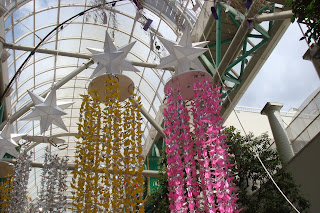Got a letter from Koriyama city letting us know some agricultural land our company owns could be eligible for decontamination. So yours truly attended a briefing one evening last week and very interesting it was too. About 40 people turned up and there were 8 officials: six from the city, two from the prefecture and two from JA, the agricultural cooperative that's going to do the work. Koriyama has a budget to clean 560 hectares (that's 1,383 acres) of farmland this fiscal year.
We were given maps showing levels of airborne radiation and soil contamination. Then we were told how it would be done. First, radiation in the air and in the soil would be measured. Then, depending on the results, zeolite and potassium fertilisers would be scattered on the land and harrowed in twice to a depth of 20 cm. (There's another method which involves deep ploughing but the city don't envisage using that.) Last year tests were done on 7 hectares of land and using this method, airborne radiation (1 cm above the soil) was reduced by 30% from 0.9 to 0.6 μSv/hr and caesium in the soil was reduced by 40% from 2,600 to 1,400 bq/kg.
There was a list of areas listed in order of airborne radiation and our land is right at the bottom so I don't think we'll be chosen. Anyway, we were told that farmers who sold their produce would have first priority, then those who grow their own food, and we don't even use the land. And it depends on the take up. Someone stood up and asked why it was voluntary. Shouldn't the city act more aggressively in getting high level areas cleaned? The answer was interesting. It seems that there's no direct relation between the radiation in the soil and the air and what eventually ends up in the plant. For example, last year, farmers were allowed to plant on soil under 5,000 bq/kg but prohibited from planting in areas over that. The results were tested at harvest but there was no direct correlation between the soil and the amount of caesium measured in the food. It seems other factors are at work such as the topography, the kind of soil and cultivation methods. One trend seems to be the fertility of the soil, particularly the amount of potassium. If the soil has lots of organic matter then the produce tends to be alright. If the soil is poor and lacking in potassium, the plants take up caesium instead.
I personally own some farmland just outside the city but it seems there are no plans to decontaminate that area. First, levels are low there and it was pointed out that if the land was cultivated last year then it's already been turned over and reduced. Moreover, Caesium 134 has a half life of two years so it's already a lot less than it was.
The overriding impression of the meeting was that this is unknown territory. The work will be done, but no one knows what's going to happen next year, there seems to be a lot of trial and error.
It is so hot. 33 'C every day. One day last week Fukushima city was 36.9'C, hottest place in the country. It's in a basin surrounded by mountains and does get very hot but if you took a child's temperature, that would be a mild fever! This is the last Sunday in August. The schools go back tomorrow.
Bye for now
Anne
















